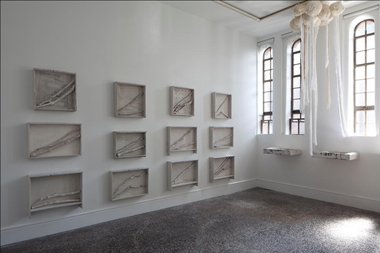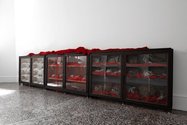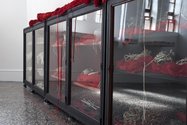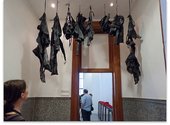John Hurrell – 10 February, 2012
On one wall is a grid of drawers showing what might be moa bones, but of dry kawakawa branches instead, covered with white slip. There's a sardonic thrust that becomes apparent when you consider that the glossy leaves of the kawakawa are used by Maori for medicine or welcoming or mourning ceremonies. It's an important symbolic plant. These dry stalks are good only for kindling. Some even have thin bandages around them.
Auckland
Christine Hellyar
Hutton and Cotton: The McGregor Museum Revisited
Curated by Andrew Clifford
20 January 2012 - 3 March 2012
In the small Gallery Two at Gus Fisher Christine Hellyar presents her own version of The McGregor Museum that is housed in the old Biological Sciences Building at Auckland University. The museum originally inhabited Old Choral Hall but in 1939 it was re-sited and considerably reduced.
Using a format she has been developing since the late seventies, Hellyar displays her deep affection (and at times dissatisfaction) with the Victorian style presentation this museum exemplifies - a formatthat was once established which now has become increasingly rare. There is a early eighties feminist and post-colonial ethos in her practice, with its replication of museum subject matter using knitting, woven fibre, ceramics, ribbons and handmade paper, a gentle irony found early on with its domestic duplication of ‘male’ tools and weapons and fascination with symbolic raw materials.
On one wall of her naturally lit space is a grid of drawers displayed flat like open, glassless cases showing what - at first glance from the labels referencing archaeological digs - might be moa bones, but of dry kawakawa branches instead, covered with white slip. There’s a sardonic thrust that becomes apparent when you consider that the glossy leaves of the kawakawa are used by Maori for medicine or welcoming or mourning ceremonies. It’s an important symbolic plant. These dry stalks are good only for kindling. Some even have thin bandages around them.
The mood continues with more drawers in front of the windows, this time parallel with the floor and containing knitted ‘models’ of geological landforms found in the book by Prof. C. A. Cotton that with its diagrams in cross-section helped Colin McCahon go beyond a cubist analysis of the landscape to something more emotionally direct. Hellyar’s use of wool is a witty reference to pakeha sheep farmers occupying an ‘empty’ landscape.
Three low, glazed and shelved cupboards dominate the other large wall. Draped in shawls and netting dyed blood red, these ostensibly contain ‘algae, fungi and flowering shrubs.’ Everything looks ossified, faded or withered - and typical of many antiquated museum displays. The labels, one assumes, visitors are meant to take with a grain of salt. It pays not to be too trusting. The referenced collections of found or handcrafted items could be interpreted as a caricature of the ordering anthropological mind set, or even of a certain variety of craft-oriented art practice that is perhaps disappearing.
Outside the room’s entrance, hung high up like a flock of scraggly bats or dead crows - each ‘creature’ individually attached - is a multi-unit black angular latex sculpture that could also be shredded or mangled clothing. Called The Thin Black Cloud this scathing comment on bicultural economic imbalances is a foil to a soft and cuddly, woolly white vertical formation, again descending from the ceiling but near Hellyar’s drawers, called The Fat White Cloud.
Despite that lack of subtlety, most of this show is understated. It is also clever, unusually emotional with its discordant, piercingly strident colour and sly in its manipulation of viewer expectations. This in spite of an eighties political ambience that makes it feel dated, and references to a method of museum presentation that now is definitely no longer current.
John Hurrell
Recent Comments
Andrew Clifford
Hi John, thanks for your comments. One small clarification with regard to historical context: The University of Auckland's McGregor Museum ...









 Two Rooms presents a program of residencies and projects
Two Rooms presents a program of residencies and projects Advertising in this column
Advertising in this column



This Discussion has 1 comment.
Comment
Andrew Clifford, 10:23 a.m. 13 February, 2012 #
Hi John, thanks for your comments.
One small clarification with regard to historical context: The University of Auckland's McGregor Museum is based on collections that date back to 1884 and, for a period, was based in Old Choral Hall. In 1939 it expanded, moving into purpose-built spaces in the Roy Lippincott designed Biology Building on Symonds Street. It was in the 1980s that the museum's displays were radically reduced in size and much of the original display furniture was thrown out. Christine, along with others, rescued some of this furniture and it is this furniture that provides much of the basis of her exhibition.
Fortunately, the McGregor is now undergoing somewhat of a revival. More info here: http://mcgregor.sbs.auckland.ac.nz/
Participate
Register to Participate.
Sign in
Sign in to an existing account.